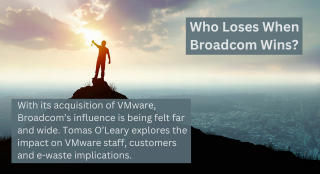“How can I help?” ITAM has a role in building a sustainable IT community (Onepak)
The following article features extracts from An IT Asset Manager’s Guide to ESG, a new ebook written by Shawn Stockman, Vice President, Sustainability Solutions at Onepak, Inc. which looks at the growing role of ITAM in sustainable IT.

How can we help?
I grew up in rural Kansas, where everyone was expected to pitch in whenever there was work to be done. On a personal level, that meant always asking oneself, “how can I help?” Once, when a local farmer had a heart attack in the middle of wheat harvest, the neighboring farmers left their own fields and harvested his wheat for him. But it wasn’t just in times of crisis that people banded together—it was an ongoing part of a shared sense of responsibility to the community. A feeling that we’re all in this together.
That mindset is what is needed now in the face of climate change and the recent emphasis on ESG (Environment, Social and Governance). But this is not a new idea.
We are all part of a global community
“Each member of the community gives himself to it, at the moment of its foundation.”
Jean Jacques Rousseau, 1762
IT asset managers (ITAMs) have a role to play in their organization’s sense of community responsibility. That role may start in defining the “community” that is impacted by the products or services your organization produces, by the people the organization employs, and by the material streams in and out of the organization. Is it limited by geography—the footprint of corporate offices or factories? Would your community comprise only your own company? Or might it also involve your peers in the profession or in your industry?
Depending on how big your organization is, the scope of your “communities” may vary, but the impact your decisions have on the planet remains the same.
Similarly, it is helpful to consider which corporate responsibilities an ITAM can affect. While the term “Corporate Social Responsibility” has been around for decades, the range of responsibilities organizations have is vast: economic, legal, ethical, philanthropic, and more recently, environmental and social responsibilities.
How ITAMs view their role affects how they view their responsibilities. We may just need a modest change of perspective.
The ITAM Hippocratic Oath
Almost 2,400 years ago, a visionary Greek physician invented a famous oath which doctors still refer to today—the Hippocratic oath. It goes something like this: First, do no harm. Respect privacy. Treat the whole patient, not the symptom. Consider the impact on the community (Covid is a great example of that).

So, what is the Hippocratic Oath for ITAMs? I would offer the following:
• Strive for carbon neutrality (net-zero)
• Wipe the data
• Work within your company
• Give back to your communities
Most hardware asset managers and the people they report to are in real positions of internal influence, if not control, when it comes to material streams in (asset acquisition) and out (asset disposition) of their organization.
What can ITAM do?
A simple shift from a “consumer” mindset to a “citizen” mindset involves addressing the responsibility of your actions and the impacts you may have on your communities.
1. Slow the pace of equipment refreshes
For example, when we slow the pace of refreshing equipment, we correspondingly slow the pace of pulling virgin materials and precious metals from the earth to make new equipment. Beyond a longer refresh cycle, consider buying refurbished equipment. According to Circular Computing, for each new laptop you avoid purchasing, you save 316KG of CO2 emissions, 190K liters of water and 1,200 KGs of earth’s resources. In this case, IT asset managers can play a crucial role in reducing the impact their company has on the environment.
2. Dispose of assets more responsibly
Additionally, ITAMs can also be social impact champions when it comes to disposing of used equipment. How about channeling some of this gear into donations to worthy community groups rather than re-marketing them for relatively modest financial return? By providing equipment to social service agencies, nonprofits, and schools, you can reduce e-waste and provide real cost savings to those institutions while providing access to people who otherwise may not have had access to a digital experience. For example, Onepak is partnering with Digitunity to provide an option for users of its ReturnCenter platform to redirect used corporate IT equipment to individuals who have none, which can positively impact their access to education, employment opportunities, legal services and healthcare. Improving digital literacy and digital equity are true positive social impacts.
3. Consider the environmental impact of your cloud solutions
According to the US Department of Energy, data centers account for about 2 percent of all electricity use in the US, consuming 10 to 50 times the energy per floor space of a typical commercial office building. The top three cloud providers—Amazon Web Services, Google Cloud, and Microsoft Azure—account for approximately two-thirds of all rentable computing services. Now you can get a better handle on your carbon footprint if you use one of these big providers.
AWS has launched the free Customer Carbon Footprint Tool to help its customers understand the carbon emissions that their EC2 instances and other computer and networking services generate.
Microsoft recently rebranded their Sustainability Calculator as Emissions Impact Dashboard, which provides transparency into greenhouse gas emissions associated with using Microsoft cloud services and enables a better understanding of the root causes of emissions changes.
Google has combined carbon reporting features in its cloud services into Carbon Sense suite, which now has an AI based feature to help customer reduce the carbon footprint of their cloud activity.
To help customers measure their carbon footprint, Salesforce is making its Net Zero Cloud 2.0 product generally available globally. The Net Zero Cloud helps companies across industries report and track sustainability data, helping them become “net zero” organizations that eliminate as much carbon in the atmosphere as they produce.
4. Track ESG data
Finally, make sure you are engaged with the people in your organization charged with tracking and reporting ESG data. If your organization uses platforms like Workday, Workiva, Optel or ServiceNow, someone has already begun capturing and reporting impact data that should include activities in your department.
How can you help?
As you can see, there are many ways in which ITAM can already contribute to building a sustainable IT community. As you consider your organization’s role as a citizen of the world and its associated responsibilities in its communities, consider your own role in making sure your organization thoughtfully answers the bigger question of “How can we help?”
Can’t find what you’re looking for?
More from ITAM News & Analysis
-
Stop Shadow IT Before It Hurts Your Business
Shadow IT often spreads quietly and quickly becomes a serious risk. Just look at the UK-based supermarket chain Co-op. A little-known remote maintenance tool used by an external IT provider was compromised. The result? Nearly 800 ... -
Why ITAM Forum Should Join the Linux Foundation: My Rationale and Your Questions Answered
TLDR. ITAM Forum has the opportunity to join the Linux Foundation as a stand-alone, self-funded project. This article covers a) What’s happening b) Why I think it’s a great move for the ITAM Forum and c) ... -
Microsoft Pricing Changes: EA Customers Face Price Increases
From 1st November 2025, Microsoft will remove all tiered pricing for Online Services under the Enterprise Agreement. This means all customers renewing or purchasing new Online Services after this date, will receive standard level A pricing ...
Software Licensing Training
Similar Posts
-
An Introduction to Scope 4 Emissions
Executive Summary For ITAM teams, sustainability is a core responsibility and opportunity. Managing hardware, software, and cloud resources now comes with the ability to track, reduce, and report carbon emissions. Understanding emission scopes—from direct operational emissions ... -
Will 'Sustainable IT' be Caught in the Crossfire?
In the days immediately following his inauguration, President Trump and his team declared war on Diversity, Equity, and Inclusion (DEI) programs at the federal level. The impact has been felt far and wide. Many government contractors ... -
Digital document solutions - why every ITAM professional should be managing one
In the face of growing environmental concerns and the urgent need for sustainable practices, the role of ITAM is expanding. Today, ITAM professionals are uniquely positioned to drive sustainability initiatives within their organisations. Sustainability in ITAM ... -
Who Loses When Broadcom Wins?
News of a new Broadcom deal rarely arrives with great fanfare. The November 2023 VMware acquisition provoked open worry online and in business circles, with many critics wondering whether the former Hewlett-Packard spinoff’s reputation would prove ...




